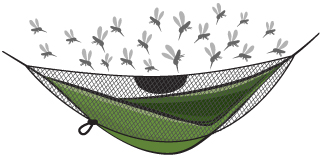Hammock Camping in Jungle & Tropical Climates
If you're travelling to a tropical or jungle area, you should always check what the local health risks are as well as the weather (will it be monsoon season?) and take the necessary precautions.
It's difficult to give specific advice for jungle hammock camping, as conditions can vary depending upon what part of the world you are in, and there are often a large number of local conditions to be aware of. Still, we hope the following tips are useful to anyone venturing into tropical climates.
What to wear
Wear clothes that cover as much of you as possible, including long trousers and long sleeved shirts (especially at night). They should also be lightweight and quick drying - natural fibres such as cotton are best, as they're also the most breathable.
It can be very difficult - sometimes impossible - to keep things dry in the jungle. Having a number of waterproof or sealable bags is extremely useful.
Avoiding insects
The number one precaution when jungle hammock camping is to avoid being bitten! Treating the mosquito net with DEET based insect repellent is advisable for jungle expeditions, and a slow-burning mosquito coil placed under the hammock at night also helps.

Which hammock?
We strongly advise using one of our hammocks with built-on mosquito nets when in the tropics or the jungle. The DD SuperLight Jungle Hammock, Travel Hammock and Frontline Hammocks all have mosquito nets - but we normally only advise on our Travel Hammock if you prefer the option of ground bivi camping, in the absence of trees (due to its base layers being waterproof but not breathable).

Mosquitos have been known to bite through single layer hammocks – luckily the above models all have two base layers, which helps prevent them biting from underneath.
Our Jungle Hammock allows the user to add or remove sections of it (such as the mosquito net and the rain cover), meaning it can be as lightweight and as minimal (or not!) as required. Its extra waterproof layer can also be used on the hammock's base, below it as a ground sheet, or above the hammock as a compact tarp.
Choosing your jungle campsite
Do not camp close to rivers! Aside from the risk from flash floods, there is also the risk of dangerous animals nearby (dependent, of course, on where you are).
Try to find a clearing that is slightly higher than the surrounding land - what is dry land when you go to sleep can turn into a river or small lake by morning.
Check the trees around your camp for insect nests – don't try and remove them! Go to a different site.
In your camp
Top tip: keep your gear off the ground. Not only does it keep everything dry, but it is VERY important to keep food and even toothpaste off the ground (ideally in a sealed container), as a number of nocturnal animals will go for these, given the chance, and you could find your rucksack destroyed in the process.
A small, additional hammock like our DD Gear Sling rigged just under or above your sleeping hammock is ideal for equipment storage, and allows you access to your gear while in your hammock!
You can also hang your bag from a tree branch.
At night set two strong 3 ft sticks into the ground near your hammock - when sitting in your hammock, take your boots off and put them on these sticks to wake up to dry, insect-free boots!
Don't forget to read our general advice on camping in summer! We also have some top tips on camping in winter, and if you're not sure which gear best suits your needs, check out our handy chart to help you choose your hammock.
 GB | GBP
GB | GBP 


